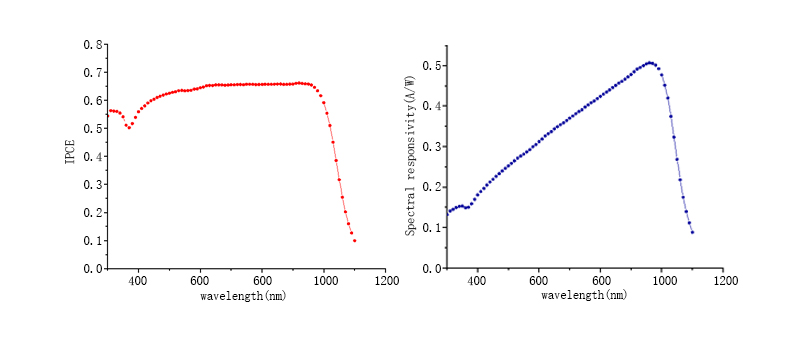As global warming continues to escalate, technologies for producing green and clean energy using sunlight are constantly evolving. Among them, photovoltaic (PV) power generation, as a technology utilizing the photovoltaic effect at semiconductor interfaces to directly convert light energy into electrical energy, has begun to be widely adopted globally. The photovoltaic conversion efficiency is a core parameter for evaluating and constraining the application of photovoltaic power generation technology in solar cell semiconductor devices.
Perfectlight Technology has launched the PL-IPCE solar cell testing system, a system for testing the photovoltaic conversion efficiency of solar cells. Equipped with a highly sensitive and strongly anti-interference lock-in amplifier system and a chopper system, it can accurately and stably measure light intensity and photocurrent.

▲ Particularly applicable ● Relatively applicable ○ Can be used
▲ Quantum Efficiency (QE) Measurement of Solar Cells
▲ IPCE Measurement of Solar Cells

IPCE of UV-enhanced Silicon Detector (top) and Spectral Responsivity (bottom)
1. High Sensitivity, Strong Anti-interference Capability
The PL-IPCE solar cell testing system adopts the American Standford SR830 lock-in amplifier to amplify weak currents, capable of measuring light currents within the range of 1 pA to 1 μA.
The PL-IPCE solar cell testing system utilizes the Standford SR540 chopper, adjustable in the frequency range of 4 to 3.7 kHz, utilizing the time correlation between the photocurrent signal and the light signal. Combined with the lock-in amplifier's filtering function, it filters out environmental light and current disturbances, further enhancing the sensitivity of current detection.
2. Three Grating Structure Design, Excellent Monochromatic Light Accuracy
The monochromator of the PL-IPCE solar cell testing system adopts a three grating structure design, with adjustable slits of 0.01 to 3 mm at the entrance and exit, ensuring the accuracy of output monochromatic light to be ±0.2 nm, with a half-peak width ≤10 nm. The monochromaticity of the output light is significantly better than that of the light source combined with a filter method.
3. Continuously Adjustable Wavelength, Able to Measure Full Spectrum Photovoltaic Conversion Efficiency
The monochromator of the PL-IPCE solar cell testing system has a continuously adjustable wavelength range of 200 to 1000 nm (three gratings: 1200 L/mm, 1200 L/mm & 600 L/mm), with a minimum wavelength adjustment of 1 nm. Compared with the method of using a light source combined with filters, it can measure the photovoltaic conversion efficiency at any wavelength within the spectrum range of a xenon lamp light source.
4. Standard Silicon Detector Certified by National Metrology Institutes, Reliable Measurement Data
The PL-IPCE solar cell testing system adopts the Japanese Hamamatsu S1337 standard ultraviolet-enhanced silicon detector, whose spectral responsivity is certified by the China Institute of Metrology Science (including certificate), covering a range of 200 to 1100 nm with a wavelength interval of 5 nm, traceable to ISO9000, which is the key guarantee for obtaining accurate measurement data.
Light Source Parameters
● Total Electrical Power of Light Source: 500 W;
● Wavelength Range of Light Source: 300 ~ 1100 nm;
Monochromator Parameters
● Focal Length: 300 mm;
● Flashing Wavelengths: 300 nm & 500 nm & 1000 nm;
● Three Gratings: 1200 L/mm & 1200 L/mm & 600 L/mm;
● Wavelength Range: 200 ~ 1100 nm;
● Resolution: 0.1 nm;
Chopper Parameters
● Chopping Frequency: 4 Hz ~ 3.7 kHz;
● Low Phase Jitter Frequency and Difference Frequency Reference Signal Output; Single Beam and Double Beam Modulation;
● With Voltage Control Input, Four-digit Frequency Display, Ten-step Frequency Control, and Two Optional Working Modes of Reference Output;
Lock-in Amplifier Parameters
● Frequency Range: 1 mHz - 102 kHz;
● Dynamic Storage: 100 dB;
● Phase Resolution: 0.01°;
● Stability: 5 ppm/°C;
● Time Constant: 10 μs ~ 10 ks;
● Photocurrent Range: 1 pA ~ 1 μA; synchronizable with reference source signal
UV-enhanced Silicon Detector Parameters
● Electrical Parameters: 10 × 10 mm2 ;
● Operating Temperature Range: -20 ~ +60°C;
● Wavelength Usage Range: 190 ~ 1100 nm;
● Dark Current (25°C; -1V): 2 × 10-10 A;
● Peak Wavelength: 960 nm;
● Peak Wavelength Responsivity: 0.5 A/W;